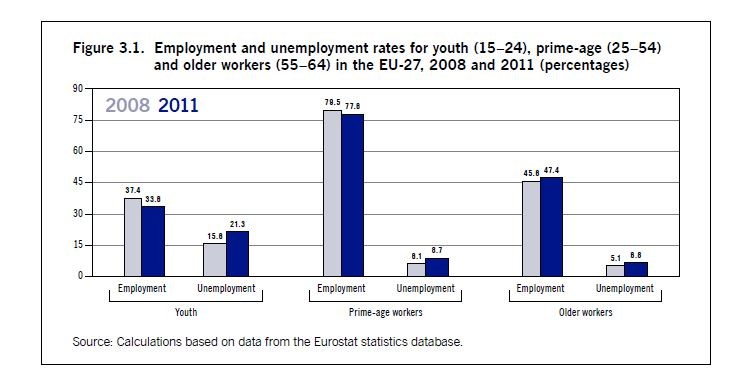ILO: No extra jobs for youths despite older workers’ retirement
Europe must handle rising youth unemployment as well as an ageing population. The fact that young people don’t step into jobs which are vacated might seem like a paradox, but this is what is happening according to the International Labour Organisation, which stages a major conference in Oslo between 8 and 11 April.
Unemployment has risen both among young workers (15-24) and older workers (55-64), but youth are the worst hit. Youth unemployment has risen from 15.8 percent to 21.3 percent between 2008 and 2011.
Unemployment has risen from 5.1 percent to 6.8 percent among the oldest workers. Unemployment among young people has risen three times more than among the oldest workers, calculated in percentage points. The numbers cover the 27 EU countries.
And youth employment has fallen; from 37.4 percent in 2008 to 33.6 percent in 2011 - a fall of 3.8 percentage points.
The opposite is true for 55-64 year olds; employment in this group has risen from 45.6 percent to 47.4 percent in the same period. Older workers have taken young people’s jobs, in other words - or taken jobs from the age group where employment is highest - 25-54 year olds (see diagram below).

“Youth will become a lost generation if they do not acquire at a young age the relevant skills, jobs in which they can use these skills and earnings with which they can live and lead a self-determined life,” ILO’s economists write in the report ‘Jobs, growth and social justice’, which was presented at the regional conference in Oslo.
The report’s statistics are from 2011, but the situation has not improved since then. Eurostat published new figures on 2 April this year which for the first time show an increase in unemployment within the Eurozone to 12 percent. The average for all 27 member countries is 10.9 percent.
There are large national differences. Crisis-hit Greece and Spain suffer the highest unemployment rates, but there are also differences in how badly hit youths are.
Youths on the edge
The most negative consequences are often felt by the so-called NEET group; not in employment, education or training. 19.8 percent of 25-29 year olds in the EU fall into this group.
Young people in work often face unusual employment conditions - 42.5 percent of EU youths have temporary jobs. That is three times the average for employable people of all ages.
29.7 percent of young people were in part-time jobs - in some cases to combine studying or family life with work. But the number of people saying they would not have chosen to work part-time has increased by five percentage points during the crisis.
There are jobs
The economic crisis has led to jobs disappearing, and that is one, but not the only, reason for the high youth unemployment. After all there are four million jobs up for grabs in the EU. This is because young people’s education does not fit the jobs. The best chances to find jobs exist on either end of the labour market - either in positions for highly qualified people with long, higher education or in low-salary jobs in the service sector.
ILO’s economists’ advice for how to fight youth unemployment and its negative consequences is not new:
- Try to reduce the number of early school leavers.
- Combine studies with practical job training in companies.
There are other more controversial ways of fighting youth unemployment. One is to introduce separate youth salaries which are lower than ordinary wages. The aim is to make youths more attractive in the labour market.
“However, such policies must be consistent with international rules and labour standards. For instance, in the case of Greece, the cut in the minimum wage for youth under 25 years of age by 32 per cent brought young people’s minimum wages below the poverty line.” the ILO writes.
Praise for youth guarantees
Youth guarantees like those introduced in Finland and Sweden get praise from the ILO, however.
According to the ILO the youth guarantees are most effective when the target groups are clearly defined and when there are resources at job centres or in municipalities to follow up these groups. The guarantees are not as efficient for youth groups who are on the edge of society.
- Read the whole report:
-

You can find the report here:
 Follow us on Facebook
Follow us on Facebook
